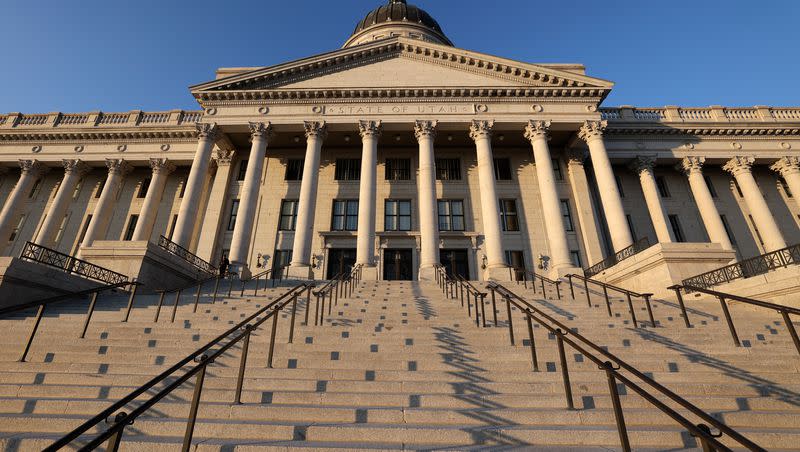‘Underwear and socks?’ Why Utah’s state budget may resemble an austere Christmas

- Oops!Something went wrong.Please try again later.
In flush budget years, government budgets are sometimes compared to “Christmas trees” that promise plenty of presents for just about everyone. But what happens when money is tight?
“Underwear and socks,” is what Utah State Senate Budget Chairman Jerry Stevenson, R-Layton, says will be under the 2024 Legislature’s “tree,” privately joking state agencies and others ought to be happy even if what they get is used as long as it’s clean.
Lately, Stevenson has been lowering expectations even more, telling reporters this week he’s taken the symbolic pair of socks off his desk when asked about upcoming Executive Appropriations Committee meetings.
Next Monday and Tuesday, the committee made up of legislative leadership will hear recommendations from the appropriation subcommittees about spending for the budget year that begins July 1.
Related
Lawmakers already approved a base budget of some $28 billion early in their 45-day session set to end March 1, a process that’s been called “quirky and obscure” and has come to be focused on identifying savings over the previous year’s spending.
And legislative leaders remain committed to a fourth year of tax cuts, no matter what.
However, Senate President Stuart Adams, R-Layton, is making it clear what’s likely to be a reduction in the state income tax rate could end up being more — or less — than the $160 million set aside in December.
A $160 million tax cut bill reducing Utah’s state income tax rate for individuals and corporations from 4.65% to 4.55%, has already passed the Senate and is awaiting a committee assignment in the House.
“The tax cut could go from $160 to $200 (million), or it could down to $120. Everything’s on the table,” Adams told reporters Tuesday. Everything, that is, except skipping another tax cut in what is an election year for all of the House and half of the Senate.
The Legislature’s GOP supermajority, which put another tax cut on their must-do list this session, still intend to follow through even if that means not funding other priorities, such as Gov. Spencer Cox’s sweeping affordable housing proposal, the Senate president said.
“Very much so,” Adams said. “That’s one thing I have not wavered on.”
House Speaker Mike Schultz, R-Hooper, has delivered a similar message during his weekly media availability last Friday.
“Giving money back to the taxpayers is a top priority for this Legislature,” Schultz said, adding that “Inflation is the No. 1 thing I hear about in my community ... so allowing people to keep more of their paychecks is important to us.”
The speaker said Utah is taking a “slow, measured approach” to cutting taxes, unlike Arizona, which faces nearly $1 billion in budget shortfalls after recently slashing income tax rates to 2.5%, The Associated Press reported.
Utah’s revenues fell nearly $50 million short in the budget year that ended June 30, 2023, thanks to lower than expected income tax collections, and lawmakers have been warned there may be more ups and downs ahead for the post-pandemic economy.
Democrats in both the Utah House and Senate have come out against any tax cut.
Related
Before any final decisions are made about adding to the base budget, the governor’s office and the Legislature have to reach an agreement on updated revenue estimates for the new budget year.
Those consensus numbers, last updated in December, will also update anticipated tax collections for the current budget year. They’re expected to be made public on Feb. 20, following the break for Presidents Day.
The announcement is likely to be much more low-key than in 2023, when lawmakers passed a record $29 billion budget that included spending another $1.8 billion on top of what was already a $5.1 billion increase.
That budget also had what was touted as $850 million in total tax relief. Besides a $400 million tax cut package reducing the state’s income tax rate, there were decreases in the state gas tax and basic property tax levy as well as a low-income housing tax credit.
Also counted as tax relief by legislative leaders last year was removing the state sales tax off food, a reduction of more than $200 million to Utah taxpayers. But that won’t happen unless voters approve an unrelated amendment to the Utah Constitution in November.
Related
Schultz pointed out that if voters do go along with changing the constitution to lift the state income tax earmark that allows those revenues to be used only for education and some social services, Utahns will end up with a “significant tax cut” this year.
“If you add that to the almost $1.2 billion in tax cuts that we’ve done over the last couple of years, that’s $1.5 billion in tax cuts, roughly,” the speaker said, labeling the reductions “a big deal.”
But House Minority Whip Jen Dailey-Provost said Wednesday there’s a “disconnect” between Republicans continuing to insist on another income tax cut this session and “in the next breath saying over and over again there’s just no money to fund” critical needs.
“Yet another income tax cut in the state of Utah is not going to lead to a hugely measurable increase in prosperity” for average Utah families, the Salt Lake City Democrat said, with the current proposed cut adding about $5 to $10 a month more in their take-home pay.
“The reality is an income tax cut disproportionately benefits higher income people. Higher income people are not the ones struggling,” Dailey-Provost said, adding she believes the money set aside for tax cuts “could be leveraged in much more effective ways.”

